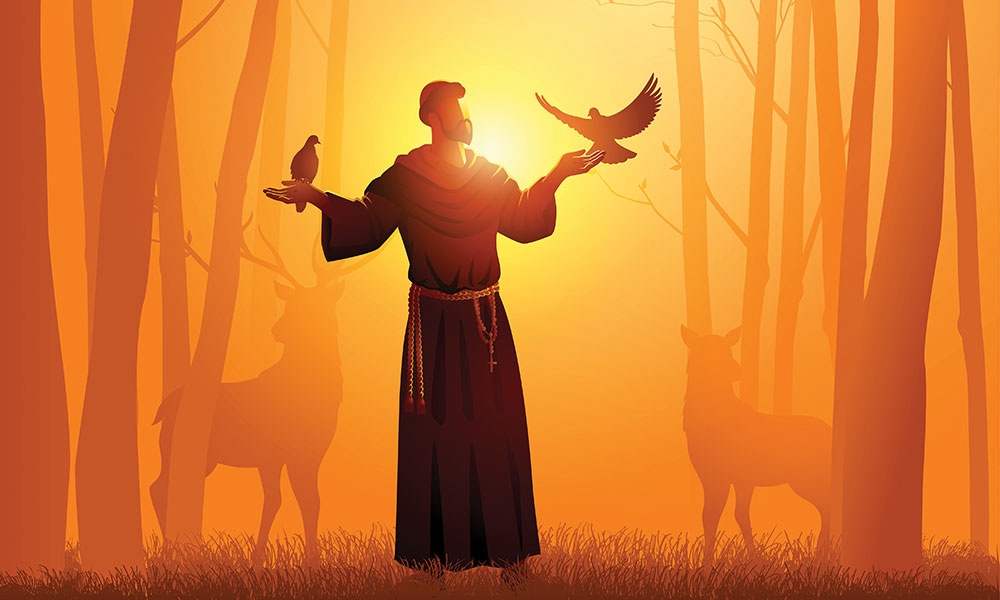
St. Francis was tender and tough
My mother grew up in very difficult circumstances, trained as a lab technician and worked in Appalachia, served in the Coast Guard in World War II, married, had four children and was then widowed after 15 years of marriage. Raising us must have been more lonely and grueling for her than we realized at the time. But she also had the ability to delight in beautiful things — music, art, books, the cherry and crabapple trees behind our house and a view of mountains.
My mother grew up in very difficult circumstances, trained as a lab technician and worked in Appalachia, served in the Coast Guard in World War II, married, had four children and was then widowed after 15 years of marriage. Raising us must have been more lonely and grueling for her than we realized at the time. But she also had the ability to delight in beautiful things — music, art, books, the cherry and crabapple trees behind our house and a view of mountains.
She was a birdwatcher from her kitchen window and the backyard. I recall her poring over a bird book to be sure she could distinguish a scarlet tanager from a cardinal, and she was once thrilled that she had seen a junco. Even ordinary sightings of house sparrows and the robins of spring stirred her. She was also a woman of faith, a devoted choir member and sometime cantor for the entirety of her adolescent and adult life.
So it’s probably not surprising that I associate her with certain familiar hymns and with St. Francis of Assisi.
When I was a teen, I was wondering what might be a good birthday present for her when I happened to see a ceramic statue of St. Francis in the window of our small-town gift shop. It was probably a combination of allowance and babysitting earnings that gave me the purchasing power to buy that statue and present it to her, boxed and wrapped.
It was a statue of the sweet Francis, the tender Francis that everyone loves — Francis with a dove right at home on his shoulder and surrounded by small animals as charming as those in Walt Disney’s “Bambi.” The little statue depicted the man who composed the Canticle of the Sun and dubbed heavenly bodies Brother Sun and Sister Moon and named natural phenomena Brother Wind, Sister Water, Brother Fire and Sister Mother Earth. This is the Francis who tamed the wolf of Gubbio and preached to birds. With this rich association with God’s creation, it is no surprise that St. John Paul II named Francis the patron saint of ecology and that Pope Francis entitled his lengthy encyclical on care for our common home “Laudato si’,” using the opening of the Canticle of the Sun as its springboard. We render homage to Francis every time we sing “All Creatures of Our God and King.”
What sometimes gets forgotten is that lovable, tender Francis had a tough side too. He risked his life by journeying to meet with Sultan Al-Malik al-Kamil in an attempt to bring peace amid the Fifth Crusade. Stories of that visit suggest that the sultan was impressed by the courage and holiness of Francis. Though the warfare didn’t end, the sultan is said to have exhorted crusaders to surrender their weapons when he was on the verge of a victory in Egypt. Instead of executing them, he gave them a safe route of escape. Francis was a rugged individual, and we can surmise that there must have been an almost ferocious quality to his spiritual intensity and powers of persuasion. He was able to soften hard hearts.
Even his famed canticle has a tough edge to it. If we’re truly paying attention and persevere to the end, we find a reality check: death awaits all of us. Francis warns, “Woe to those who die in mortal sin./Blessed are those whom death will find in Your most holy will.” And he concludes with an exhortation to praise, bless, give thanks and serve humbly.
St. Francis didn’t call us to an easy life. He certainly didn’t envision earth as Eden before the Fall, even as he praised God for things of this world.
Then there is that other favorite prayer that has come down to us from the saint: “Make me an instrument of your peace,” it begins. We can focus on the tender parts: the call to love, pardon, faith, hope, light, joy, consolation, understanding, generous giving. We are called to be channels of all these. But again, as we look closely we see that Francis presumed that in this life we will indeed encounter hatred, discord and injury, doubt, despair, darkness, sadness, misunderstanding, grief.
As we conclude the annual Season of Creation — held from Sept. 1 to the celebration of the feast of St. Francis on Oct. 4 — it will be helpful for us to remember that it is possible to revel in the beauty and bounty of God’s good earth while also insisting on the triumph of good over evil. We love and endure, and endure, and endure, in the spirit of Christ and with his grace.
I’m glad the statue of St. Francis has survived all these years. It came back to me after my mother’s death in 2011 and graces a prominent shelf in my office. It reminds me, as she did, that we can love life while doing our best to survive harshness and heartbreak. We can counter evil with a mixture of grit, gratitude for small things, gentleness and a steadfast and sometimes stubborn faith.
Sister Pamela Smith, SSCM, Ph.D., is the diocesan director of Ecumenical and Interreligious Affairs. Email her at psmith@charlestondiocese.org.
